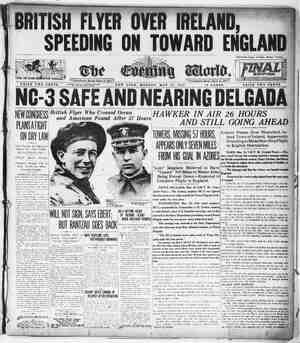The Nonpartisan Leader Newspaper, May 19, 1919, Page 5
You have reached the hourly page view limit. Unlock higher limit to our entire archive!
Subscribers enjoy higher page view limit, downloads, and exclusive features.
milk producers in the United States, living along millions of miles of country roads. Milk is perish- ‘able, and must be handled collectively, either for distribution or manufacture. The farmers can combine only locally, and they are compelled to combine by the very nature of their perishable product. Where the milk producers are not organ- ized, there is a great waste of fresh milk every day —due to nondelivery or to lack of a sufficient mar- ket near at hand. “Since the war began,” Campbell says, “the or- ganized milk producers, including the men who are being haled into the criminal courts in Chicago, have been asking the government to ascertain the cost of producing milk, and then to say to them what would be a reasonable profit. Herbert Hoover, food administrator, appointed an eminent commis- sion for this purpose, and that commission reported after months of investigation that— “With labor at 30 cents per hour, grain at $65 per ton, hay at $20, silage and other succulent feed at $8 per ton, etc., the cost. to the farmer of 3.5 milk (the average milk) will be $3.56 per hundred for the entire year, average; for the month of March it would be $3.77. . “If you will take the daily market reports of the present, you will discover that every item of cost in milk production is above the basic prices taken by the United States investigators.” : The cities of San Francisco, Detroit, New York and Boston each conducted an investigation’into the cost of producing good milk, during the past season, having the help of the commercial bodies, labor organizations and boards of health. In each in- THE WELCOME GUEST stance the cost of production was found to be higher than was announced -by the Hoover commission. No other findings have been reported in this coun- try. Yet the prices paid the farmers near Chicago have never reached the figures approved by Hoover. In conclusion, Campbell says frankly that al- though he represents “many hundreds of thousands of organized farmers, milk producers, and I be- lieve millions of other milk producers and farmers unorganized, I do not flatter myself that this letter will ever reach you,” but that “this protest will have been filed, either in the wastebasket of the secre- tary or in some forgotten place.” However, should it reach the president, he asks the opportunity to personally bring to the president the proofs of all his statements as to the wrong done the farmers in this persecution. N (N n V4 A\ N\ AN o NG & N 75 S = N B O R e S A% MOTHER ! cotE DOWN , STAIRS THERES SOME ®opY To SEE YO < N\ N > SEE PAGE FIVE T ME MO L SHALL W(Te THAT RGP A TSR ST A T A ( ((CC( (o= I, ((QF ((CAy | ({{e i \ @ - = - 7 (T G \( (& Q R i | ‘\ \\ —— —Drawn expressly for the Leader by W. C. Morris,







